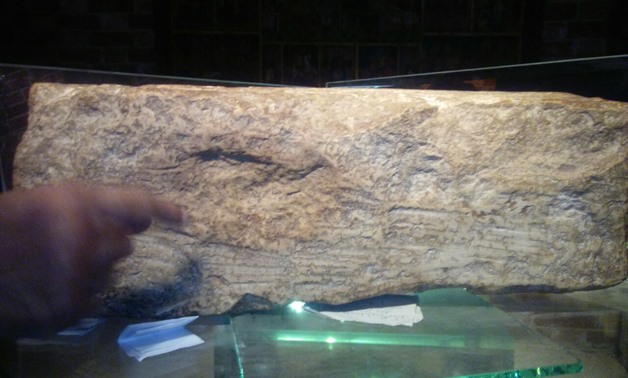
“Christ’s footprint” on a rock in the church of Sakha – Mohamed Suleiman
CAIRO – 31 October 2017: The Holy Family left Sebennytos for Xois, taking refuge in the shadows of Egypt’s northern fields and trees. Known today as Sakha, we asked farmers in the town for directions to the ancient Church of Virgin Mary, but no one knew where it was for sure, until a lady in her fifties wearing a cross accurately described the way to the church.
A few minutes later, we were able to see the walls of the ancient church. Like most churches, it was secured by the police. We were kindly received by Father Mathew Morris.
“Sakha is unlike all the cities that Jesus visited with his mother,” Morris said, explaining that the name is derived from a Coptic phrase that means “the heel of Christ”.
Christ is believed to have struck wells in the towns and villages he visited. Some of these wells dried up, while some keep flowing to this day and are sites for receiving blessings. Here in Sakha, the child Christ placed his footprint on a rock, from which a well sprang, and his footprint lasts until today, according to Coptic tradition.
 Father Morris at the rock that has “Christ’s footprint” – Mohamed Suleiman
Father Morris at the rock that has “Christ’s footprint” – Mohamed Suleiman
The rock is 60-centimeter long and 15-centimeter wide. The priest took it in his hands and pointed to the little footprint. The rock was of a sandy yellow color, while the footprint was brownish.
Father Morris said the church was built on the site of an older monastery, which was known as the Baptism Monastery, and was teaming with monks up to the end of the 13th century. When the monastery was demolished, the monks disappeared, yet they wrote the words “God is one” on the rock before leaving it behind to make it easily distinguishable from other rocks. The rock was hidden for many years over fears of being stolen. It was rediscovered in 1984, when Anba Beshoy announced its authenticity.
 The Coptic Church believes Christ left his footprint on this rock in the church of Sakha – Mohamed Suleiman
The Coptic Church believes Christ left his footprint on this rock in the church of Sakha – Mohamed Suleiman
In addition to the rock, the church also contains a monumental icon that was drawn by the painter Anstas the Roman, a man whose name would be mentioned again and again from then on in the history of the Coptic Church. He was a Roman painter who came from Jerusalem to draw icons, and left numerous relics that date back to the 5th century.
 “God is one” carved in Arabic on the other side of the rock on which Christ is believed to have left his footprint in the church of Sakha – coptichistory.org
“God is one” carved in Arabic on the other side of the rock on which Christ is believed to have left his footprint in the church of Sakha – coptichistory.org
Every year on the first of June, the Coptic Church celebrates the memory of the arrival of the Holy Family to Egypt. The church of Sakha celebrates it by organizing a huge spiritual “moulid” that is attended by a large number Christians and Muslims. The celebration includes beautiful singing of hymns, uttering trills of joy, and touching Christ’s footprint for blessings. It is known that one of the practices of the Coptic Church is keeping the relics of saints in special, candlelit rooms where people can touch them for blessings.
 “Christ’s footprint” on a rock in the church of Sakha – Mohamed Suleiman
“Christ’s footprint” on a rock in the church of Sakha – Mohamed Suleiman
The historic churches in Egypt’s Nile Delta are not included in the Vatican’s list of pilgrimage sites in Egypt, be it Musturud, Semannud or Sakha. These churches are far apart, so they cannot be visited in a single day, and they are located in busy rural areas surrounded by farmland.
Although these towns do not include major tourist attractions, they reveal the original image of Egypt’s countryside in terms of farming habits, traditional clothes, and the immense importance of the Nile River to the farmers, and they provide an opportunity to interact with the kind, friendly locals. It would especially be quite an experience to visit during one of the moulids held by the historical churches of these towns. A moulid is a huge event that celebrates a Christian or Muslim figure and is attended by the followers of the two religions.
The next stop of the Holy Family would be in Wadi el-Natrun, where a complex of beautiful monastries with full monastic life has been included on the Vatican’s list.
Translated by Heba Fadel
Additional reporting by Hanan Fayed




Comments
Leave a Comment